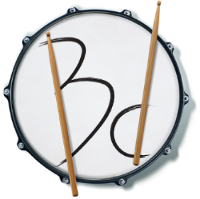Paradiddle Power: Applying Rudiments to Drum Set
If you’re a beginner drummer practicing your first rudiments, you may ask yourself at some point, “what’s the purpose of learning these?” Many experienced drummers talk about applying rudiments to the drum set, but doing so leaves lots of room for interpretation. Depending on how a pattern is applied to the drums, it could function as a groove, a drum fill, or even become the basis of an entire solo.
What are Rudiments?
Rudiments are short rhythmic fragments that have a specific sticking pattern associated with them. They predate the modern drum set by decades and are the building blocks to more expressive vocabulary. Played on just a snare drum or practice pad, they’re a fantastic way for drummers to develop their control, technique, and ability to utilize different inflections. When mapped around the drum set, they can take on a much more melodic quality and allow drummers to move in different paths around the kit.
There are 40 “Essential” rudiments, but in this article, we’re going to focus on only one rudiment: single paradiddles.
The Humble Single Paradiddle
Single paradiddles consist of a mixture of single strokes and double strokes: R L R R L R L L. Phrased as 16th notes, the leading hand alternates from one beat to the next. This pattern is among the first that most beginning drummers learn and can be used to create an impressive amount of musical content depending on how they’re applied.
Before taking this pattern and working out ways to play it around the drum set, first practice it on just the snare drum (or a practice pad). Begin practicing the sticking pattern as 8th notes (two strokes per beat) to give your brain a chance to work faster than your hands move. In the below video, the paradiddles are demonstrated as 8th notes, and then 16th notes.
Groove Applications
If you place your right hand on the hihats, keep your left hand on the snare drum, and add kick in a few places, you can build grooves around single paradiddles. To really make things sound good and flow, a variety of dynamics are crucial, particularly on the snare drum. You should accent beats 2 and 4 on the snare and play all of the snare strokes as ghost notes. If you’re unfamiliar with those terms, an accent is a stroke that’s played louder compared to others. Ghost notes are the opposite - they’re played quieter compared to other strokes. Using a combination of accents and ghost notes gives the groove a lot more dimension while retaining a steady backbeat. Below are 4 grooves built around single paradiddles played using only the kick, snare, and hihats.
Another way to apply single paradiddles is to keep your right hand on the ride cymbal and have your left hand switch between playing on the hihats and the snare drum. This approach provides some different textures in the form of sustain from the ride cymbal and more voices (sounds) happening simultaneously. Nailing down the positioning of the left hand can be a bit tricky at first, so start off slowly and gradually build it up.
Drum Fills
Orchestrating paradiddles around the drums opens up countless fill possibilities. The sticking pattern allows for different paths around the drum set that would otherwise be quite difficult to execute using only single strokes or only double strokes. In addition to unlocking various ways of moving around the drums, orchestrating paradiddles also opens up many melodic possibilities. There are literally millions of different ways to orchestrate them, but below are just 4 to get you started.
To really encode some of these paradiddle applications into your playing, try creating some of your own grooves and explore other orchestrations and dynamic inflections. Trial and error is one of the best ways to develop your own individual sound and will help strengthen your musical sensibilities. This approach works for practically any rudiment. See if you can create grooves or fills out of similar rudiments, such as double paradiddles or paradiddle-diddles. And above all, have fun messing around!




